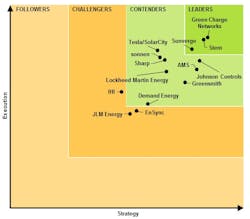Energy storage leaders named by Navigant
Green Charge Networks, Stem, and Sunverge top a new list published by Navigant of distributed energy storage leaders.
The energy storage leaders are driving growing use of the resource as means to lower costs for customers and for the larger grid. Commercial buildings use energy storage for back-up power during outages and to reduce their utility demand charges. Meanwhile, energy storage also can act as a virtual power plant and provide a capacity resource for the grid.
“Leaders in the distributed-scale ESS sector have built on innovative software platform capabilities to focus on playing multiple roles across the delivery value chain,” says William Tokash, senior research analyst with Navigant Research. “As a result, they can drive down costs, enable financing innovation, and establish customer access advantages relative to their peers.
Credit: Navigant Research
An executive summary of the report, Navigant Research Leaderboard Report: Distributed-Scale Energy Storage Systems Integrators, is available on Navigant’s website.
Other energy storage leaders on Navigant’s list are: Johnson Controls, Advanced Microgrid Solutions, Tesla/SolarCity, Sharp, sonnen, Greensmith and Lockheed Martin Energy.
And speaking of energy storage leaders…
Energy industry veteran Kelly Speakes-Backman will become the Energy Storage Association’s first chief executive officer on July 1. Speakes-Backman joins ESA from the Alliance to Save Energy, where she was senior vice president of policy and research.
As part of the organizational change, Matt Roberts’ role will change from executive director to vice president.
ESA is making the changes to ramp up its push for 35 GW of energy storage by 2025.
Big leadership changes underway in New York too
New moves also are underway at the New York State Energy Research and Development Authority (NYSERDA), where Massachusetts clean energy veteran Alicia Barton is now president and CEO. Barton takes over from John Rhodes, who became chair of the Public Service Commission. He replaces Audrey Zibelman, who joined the Australian Energy Market Operator.
Barton was most recently at the law firm of Foley Hoag in Boston and previously worked as chief of operations for the Global Utility group at SunEdison. She also served as CEO of the Massachusetts Clean Energy Center (MassCEC), a quasi-public agency.
Mayors press for 100 percent clean and green
The U.S. Conference of Mayors approved a goal to move toward 100 percent clean energy in cities across the United States this week.
“By approving this historic measure, we are showing the world that cities and mayors can and will lead the transition away from fossil fuels to 100 percent clean, renewable energy,” said Columbia Mayor Steve Benjamin. “There is more work to be done to realize this vision for our nation, but this vote represents an important first step towards cleaner air and water for our families, more good-paying jobs in clean energy, and stronger cities across the country. ”
If all of the cities that belong to the U.S. Conference of Mayors achieved the goal by 2025, they would make anywhere from 87 percent to 110 percent of the remaining carbon reductions for the U.S. under the Paris Agreement, according to the Sierra Club.
“What better way to kick off Donald Trump’s energy week than with a message from our nation’s mayors that cities are ready for 100 percent clean and renewable energy,” said Sierra Club Executive Director Michael Brune. “Cities don’t need to wait for Washington, D.C. to act in order to move the ball forward on clean energy. While Donald Trump props up corporate polluters that are threatening the health of people across our country, mayors are showing that local leaders can and will lead our nation toward a healthier, stronger and more prosperous future powered
There is still a long way to go. Only 36 cities have committed to a 100 percent goal out of more than 3,000 cities in the U.S. The U.S. Conference of Mayors vote is likely to encourage more.
Track news about energy storage and microgrids by following Microgrid Knowledge on Twitter @MicrogridNews .







